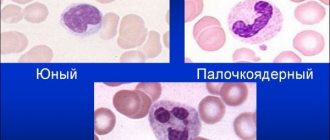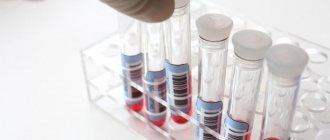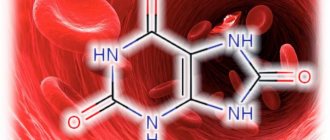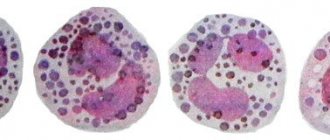Many people are interested in a table that shows the norm of cholesterol in men by age. They want to see it because they have heard more than once about how harmful “bad” cholesterol is, how important it is to monitor it, and that it can increase the risk of developing cardiovascular diseases and atherosclerosis.
But do these statements correspond to reality, how does the level of cholesterol in the blood of men change with age and how can it be lowered? Let's talk about everything in order.
What is cholesterol
Cholesterol is a waxy, fat-like organic compound found in all cells of our body. It is produced by the liver, and cholesterol is also found in a number of foods, such as meat or milk.
Cholesterol is vital for the body, as it is actively involved in the production of vitamin D, as well as various steroid hormones.
Cholesterol and pregnancy: should you worry?
During pregnancy, the level of lipids of all fractions, except LDL, gradually increases, reaching a maximum concentration by the end of the third trimester. Such changes should not alarm a woman. They are absolutely normal and are explained by the metabolic restructuring of the body and the needs of the fetus:
- The body of the expectant mother synthesizes a large amount of steroid hormones necessary for the normal course of pregnancy, the raw material for which is cholesterol. This causes the liver to produce more sterol.
- The second reason for the sharp increase in the level of total cholesterol, LDL, HDL, and triglycerides is the peculiarities of fat metabolism in a pregnant woman. In the first and early second trimester, adipose tissue accumulates. When the fetus begins to rapidly gain weight (third trimester), the body starts breaking it down. Activation of lipolysis is accompanied by an increase in plasma lipid content.
How is blood cholesterol measured?
A blood test for cholesterol is called a lipid profile, or lipid profile. It includes several main indicators:
- total cholesterol (TC);
- high-density lipoprotein (HDL) cholesterol—also known as “good” cholesterol;
- low-density lipoprotein (LDL) cholesterol—called “bad” cholesterol;
- triglycerides (TG).
How to prepare for a lipid profile
Anyone can take a lipid profile, but you should prepare for this procedure in advance, otherwise the indicators may be inaccurate. If you are planning to take this test, then ideally you should not drink alcohol for three days or at least a day before going to the clinic.
The night before, refrain from having a heavy dinner with fried, fatty or sweet foods. Try to eat early - no later than 20:00. In the morning - no coffee, tea, mineral water, juice or other sweet drinks - you can only drink plain water.
If you are taking any medications or biologically active substances, check with your doctor whether you can take them before the test, or they may distort the data.
Reasons for the increase
Let's find out why women may have elevated levels of total cholesterol in their blood.
Menopause is common and, perhaps, the main reason for the increase in this indicator in women. Menopause brings with it a lot of worries and concerns, including problems with cholesterol. Heredity can sometimes also play a cruel joke, “rewarding” a woman with a congenital increase in blood cholesterol levels: the same problem as her mother.
More reasons:
- disorders of the kidneys.
- Liver diseases and diabetes.
- Pregnancy, especially the first trimester.
- Obesity.
- Pancreatic diseases and hypertension.
Female alcoholism is a dangerous thing from all sides.
Alcohol also has a negative effect on the level of this indicator. Some medications can also have an effect: for example, diuretics. In this case, cholesterol sometimes cannot be normal, but after completing the course it comes into balance. Improper and unbalanced nutrition is a serious cause of changes in cholesterol levels. Excess of low-quality fat, preservatives, and other substances harmful to the body cause many problems, and high cholesterol is one of them. It should be noted that with age, all these reasons begin to influence the increase in cholesterol faster and stronger. Therefore, women over 50 years of age should undergo a lipid profile test at least once a year. Because what is considered the norm at 20 years old is no longer the norm at 50 years old.
Signs
If cholesterol in women is elevated, and treatment is not carried out, then the following alarming symptoms are possible:
frequent headaches, sometimes exhausting, loss of balance out of the blue, problems with memory, remembering even work and everyday moments, insomnia.
At the stage of detecting these symptoms, it is necessary to take an analysis, and if the diagnosis is confirmed, treatment should be started immediately. If you ignore the warning signs, the problem can lead to atrophy of brain cells, and then to degradation and dementia. With these symptoms, it is especially important to observe what the norm is for women after 60 years and after 70 years.
Cholesterol: normal for men by age
Only a doctor should interpret the results obtained after a lipid profile, since healthy and elevated indicators will vary from person to person and depend on many different factors, ranging from his lifestyle to the time of year.
One of the main parameters influencing high cholesterol in men is age. The older we get, the more cholesterol our bodies produce. Below are the average levels of cholesterol in the blood of men at different periods of life.
| Age | Total cholesterol | LDL | HDL |
| 20-25 years | 3.16 — 5.59 | 1.71 — 3.81 | 0.78 — 1.63 |
| 25-30 years | 3.44 — 6.32 | 1.81 — 4.27 | 0.80 — 1.63 |
| 30-35 years | 3.57 — 6.58 | 2.02 — 4.79 | 0.72 — 1.63 |
| 35-40 years | 3.63 — 6.99 | 1.94 — 4.45 | 0.88 — 2.12 |
| 40-45 years | 3.91 — 6.94 | 2.25 — 4.82 | 0.70 — 1.73 |
| 45-50 years | 4.09 — 7.15 | 2.51 — 5.23 | 0.78 — 1.66 |
| 50-55 years | 4.09 — 7.17 | 2.31 — 5.10 | 0.72 — 1.63 |
Doctors recommend that healthy men undergo a lipid profile every 4-6 years to monitor rising cholesterol levels.
What does elevated fat levels indicate and how can you reduce the amount of unhealthy fat?
If cholesterol is not normal, you should undergo additional tests to identify pathologies:
- hearts;
- liver and kidneys;
- thyroid gland.
This is just a general list of diseases that are caused by high levels of fat in women.
In women, the level of fat in the blood depends not only on age. When laboratory results are interpreted, additional factors that cause a decrease or increase in lipids are taken into account, for example:
- Seasonality. At different times of the year, the level of organic compounds in women decreases or increases. In winter, the concentration increases by about 2-5%. This deviation is not considered a pathology in women. This is a physiologically normal indicator.
- Menstrual cycle. In the first half of the cycle, the female body produces a large amount of hormones. Deviation from normal indicators during this period can reach 9%. This is the norm for cholesterol in women after 40 and 50 years of age.
- Pathologies. With angina pectoris, arterial hypertension (during attacks), acute respiratory infections, the lipid level in the blood decreases significantly. This condition can persist for a day or a month. Indicators for women decrease by 13-15%.
- Oncological diseases. In the presence of malignant tumors, the concentration of lipid levels decreases significantly. This is due to the active growth of abnormal cells. They require a lot of fat to grow.
- Heredity. In some people, at the genetic level, the amount of cholesterol may be slightly lower or higher. This is not considered a pathology.
- Poor nutrition. Eating unhealthy foods – fried, too fatty foods – leads to increased lipid levels. Fried crust on potatoes and kebabs is nothing more than harmful cholesterol deposited in the blood vessels. The same thing happens when there is no fiber in the diet.
- Taking medications. Use of specific steroid and progestin medications; antibacterial agents; special medications (used, for example, by athletes to increase muscle size) lead to deviations from normal fat levels. In addition, many medications interfere with liver function, thereby reducing the production of healthy fat.
- Passive lifestyle. Today's pace of life in women leads to blood stagnation, which ensures an increase in the level of harmful lipids.
It is better to ask a specialist what normal cholesterol level a woman has, who will examine the general condition of the body and the presence of minor pathologies.
The relationship between cholesterol and cardiovascular disease
For half a century, high total cholesterol (TC) or low-density lipoprotein cholesterol (LDL) has been recognized as a major cause of atherosclerosis and cardiovascular disease (CVD), and statin treatment has been widely advocated for the prevention of CVD.
However, more people are realizing that these mechanisms are more complex and that statin treatment, especially when used as primary prevention, is of questionable benefit.
In 2020, a truly revolutionary study by 15 scientists from around the world was published in the specialized journal Expert Review of Clinical Pharmacology, who questioned the link between high cholesterol levels and the risk of developing cardiovascular diseases.
The hypothesis that high total cholesterol (TC) causes cardiovascular disease (CVD) was put forward in the 1960s by the authors of the Framingham Heart Study.
However, in their 30-year follow-up study published in 1987, the authors reported that “for every 1 mg/dL per year decrease in TC, there was an eleven percent increase in coronary and all-cause mortality.”
In the years following the Framingham Heart Study report, numerous studies have shown that high TC is not associated with future CVD risk.
For example, a 2004 Austrian study including 67,413 men and 82,237 women who were followed for many years found that AC was weakly associated with mortality from coronary heart disease in men, except for those aged 50 to 64. years.
There was also no association between TC and mortality due to other CVDs, except that low TC was inversely associated with CVD mortality in women over 60 years of age.
Today, the general consensus is that total cholesterol is not the most useful or accurate predictor of CVD, and interest is increasingly focusing on low-density lipoprotein (LDL) cholesterol.
If high levels of “bad” cholesterol (LDL) are the culprit of cardiovascular disease, then this indicator should be higher than normal in patients with CVD.
However, in a large American study of nearly 140,000 patients with acute myocardial infarction, LDL levels were actually below normal at hospital admission.
In another study with the same conclusion, the authors decided to further lower patients' LDL levels, but at three-year follow-up, overall mortality among patients with bad cholesterol below 105 mg/dL (2 mmol/L) was twice as high. than in patients with higher LDL levels.
Reverse causation has been proposed to explain the inverse association between mortality and LDL levels; for example, that cancer and infections can lower levels of “bad” cholesterol.
However, a more likely explanation, according to the authors of the study, is that cardiovascular disease can be caused by infections and that LDL directly inactivates almost all types of microorganisms and their toxic products.
Consistent with this finding is the observation that healthy people with low levels of bad cholesterol have an increased risk of both infectious diseases and cancer. The latter is possible because microorganisms have been linked to almost 20% of all cancer types.
Diet
It’s not enough to know what foods to eat to lower cholesterol. It is important to understand what foods are strictly prohibited and how to properly prepare permitted foods. The diet excludes the consumption of the following foods and dishes:
- pies, rich bread, all flour products;
- dairy products with a fat content of more than 1.5%;
- fatty meats;
- coffee;
- alcohol;
- mayonnaise;
- smoked meats;
- fast food.
Your weekly diet must include fish, preferably sea fish. It can be baked, stewed, boiled, or made into fish soup. It is undesirable to eat salted fish, because salt increases blood pressure and worsens the condition of blood vessels. Together with hyperlipidemia, this increases the risk of cardiovascular disease. Fish oil, a natural statin that has the property of regulating the amount of lipids in the body, is considered a particularly useful seafood product for lowering cholesterol.
Advice! When frying, the beneficial fatty acids in fish are quickly destroyed, such a dish will only cause harm! Steaming fish, stewing, baking – this heat treatment helps preserve its beneficial properties.
Another useful product is garlic. Every day you need to eat 2-3 cloves, adding them fresh to different dishes. Many people like vegetable salads with garlic and lemon. This dressing is not only healthy, but also delicious.
All dishes must be stewed, boiled or baked. It is strictly forbidden to fry or smoke meat. You should eat at least 4-5 times a day in small portions. Following such a diet helps normalize body weight, as well as cholesterol and blood sugar levels.
The relationship between cholesterol and atherosclerosis
If high total cholesterol (TC) causes atherosclerosis, then it is logical to assume that people with high total cholesterol (TC) should have more cases of atherosclerosis than people with low total cholesterol.
However, in 1936, scientists Lande and Sperry found that, after adjusting for age, people with low TC had the same chance of becoming atherosclerotic as people with high TC. Since then, their observation has been confirmed in at least a dozen studies.
A weak association between AC and the degree of atherosclerosis has been found in some studies, but the authors studied only patients admitted to hospital and therefore may have included patients with familial hypercholesterolemia (blood lipid disorders).
Because the percentage of such patients in the cardiology department is significantly higher than in the general population, the data may have been biased. If high TC levels were indeed the main cause of atherosclerosis, then a corresponding response should be observed in trials of cholesterol-lowering drugs.
For example, the arteries of those people whose lipid levels were most reduced would be healthier. However, in a review of 16 cholesterol-lowering studies, this correlation was present in only one of them, and in that study the only treatment was exercise.
Symptoms of high cholesterol (table)
To begin with, we suggest that you familiarize yourself with the indirect and obvious signs of high cholesterol. Indirect, because they can signal – and about a host of other health problems. Obvious, because it is these phenomena that specifically point to our problem.
Indirect signs
| Brain vessels: | Venous system of the legs: |
| Recently you often suffer from headaches (not a “fresh” head); | muscle pain appeared (when walking), cramps at night (or in the morning); |
| at night, painful insomnia (to the point of headache) haunts me; | Recently your toes have often become numb; |
| frequent dizziness, which is accompanied by “darkening” in the eyes; | feet often “freeze” (during moments of rest); |
| You have noticed some disturbances in the coordination of movements (things do not “hold” in your hands); | skin color has changed (trophic ulcers have appeared); |
| memory has deteriorated (difficulty concentrating on thoughts/daily tasks). | excessively “swollen” veins (you have not noticed this before). |
Obvious signs
They usually appear already at a severe/advanced stage of the disease.
- xanthelasma:
(formed on the eyelids (most often, closer to the bridge of the nose) - “nodules” of an unpleasant dirty / yellow color, over time they increase in size / new ones appear);
- lipoid corneal arch
(the most common phenomenon in smokers (both men and women) under the age of 50, but by and large it is of an age-related / hereditary nature).
| lipoid arch (photo) | xanthelasma (photo) |











